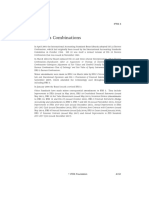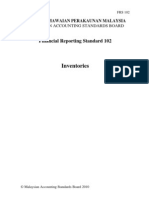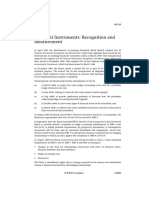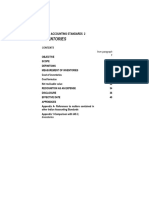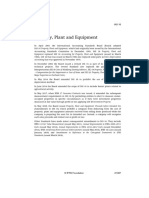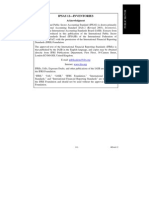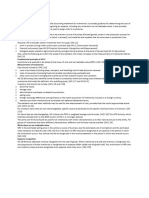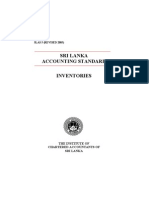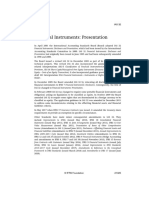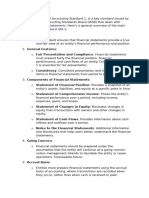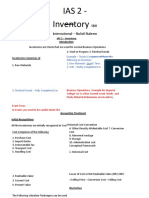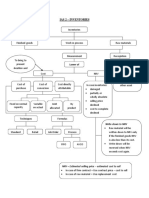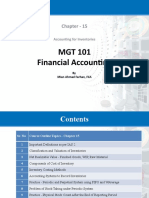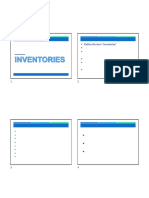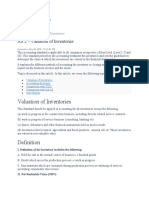Annotated BB2023 A IAS02 PartA PDF
Annotated BB2023 A IAS02 PartA PDF
Uploaded by
Khutso MabalaCopyright:
Available Formats
Annotated BB2023 A IAS02 PartA PDF
Annotated BB2023 A IAS02 PartA PDF
Uploaded by
Khutso MabalaOriginal Title
Copyright
Available Formats
Share this document
Did you find this document useful?
Is this content inappropriate?
Copyright:
Available Formats
Annotated BB2023 A IAS02 PartA PDF
Annotated BB2023 A IAS02 PartA PDF
Uploaded by
Khutso MabalaCopyright:
Available Formats
IAS 2
IAS 2
Inventories
In April 2001 the International Accounting Standards Board (Board) adopted IAS 2
Inventories, which had originally been issued by the International Accounting Standards
Committee in December 1993. IAS 2 Inventories replaced IAS 2 Valuation and Presentation of
Inventories in the Context of the Historical Cost System (issued in October 1975).
In December 2003 the Board issued a revised IAS 2 as part of its initial agenda of
technical projects. The revised IAS 2 also incorporated the guidance contained in a
related Interpretation (SIC-1 Consistency—Different Cost Formulas for Inventories).
Other Standards have made minor consequential amendments to IAS 2. They include
IFRS 13 Fair Value Measurement (issued May 2011), IFRS 9 Financial Instruments (Hedge
Accounting and amendments to IFRS 9, IFRS 7 and IAS 39) (issued November 2013),
IFRS 15 Revenue from Contracts with Customers (issued May 2014), IFRS 9 Financial
Instruments (issued July 2014) and IFRS 16 Leases (issued January 2016).
© IFRS Foundation A1221
IAS 2
CONTENTS
from paragraph
INTERNATIONAL ACCOUNTING STANDARD 2
INVENTORIES
OBJECTIVE 1
SCOPE 2
DEFINITIONS 6
MEASUREMENT OF INVENTORIES 9
Cost of inventories 10
Cost formulas 23
Net realisable value 28
RECOGNITION AS AN EXPENSE 34
DISCLOSURE 36
EFFECTIVE DATE 40
WITHDRAWAL OF OTHER PRONOUNCEMENTS 41
APPENDIX
Amendments to other pronouncements
APPROVAL BY THE BOARD OF IAS 2 ISSUED IN DECEMBER 2003
FOR THE BASIS FOR CONCLUSIONS, SEE PART C OF THIS EDITION
BASIS FOR CONCLUSIONS
A1222 © IFRS Foundation
IAS 2
International Accounting Standard 2 Inventories (IAS 2) is set out in paragraphs
1–42 and the Appendix. All the paragraphs have equal authority but retain the IASC
format of the Standard when it was adopted by the IASB. IAS 2 should be read in the
context of its objective and the Basis for Conclusions, the Preface to IFRS Standards and
the Conceptual Framework for Financial Reporting. IAS 8 Accounting Policies, Changes in
Accounting Estimates and Errors provides a basis for selecting and applying accounting
policies in the absence of explicit guidance. [Refer: IAS 8 paragraphs 10–12]
© IFRS Foundation A1223
IAS 2
International Accounting Standard 2
Inventories
Objective
1 The objective of this Standard is to prescribe the accounting treatment for
inventories. A primary issue in accounting for inventories is the amount of
cost to be recognised as an asset and carried forward until the related
revenues are recognised. This Standard provides guidance on the
determination of cost and its subsequent recognition as an expense, including
any write-down to net realisable value. It also provides guidance on the cost
formulas [Refer: paragraphs 23–27] that are used to assign costs to inventories.
Scope
2 This Standard applies to all inventories, except:
(a) [deleted]
(b) financial instruments (see IAS 32 Financial Instruments:
Presentation and IFRS 9 Financial Instruments); and
(c) biological assets related to agricultural activity and agricultural
produce at the point of harvest [Refer: IAS 41 paragraph 13]
(see IAS 41 Agriculture).
3 This Standard does not apply to the measurement of inventories held by:
[Refer: Basis for Conclusions paragraphs BC6–BC8]
(a) producers of agricultural and forest products, agricultural produce
after harvest, and minerals and mineral products, to the extent that
they are measured at net realisable value in accordance with
well-established practices in those industries. When such
inventories are measured at net realisable value, changes in that
value are recognised in profit or loss in the period of the change.
(b) commodity broker-traders who measure their inventories at fair
value less costs to sell. When such inventories are measured at fair
value less costs to sell, changes in fair value less costs to sell are
recognised in profit or loss in the period of the change.
4 The inventories referred to in paragraph 3(a) are measured at net realisable
value at certain stages of production. This occurs, for example, when
agricultural crops have been harvested or minerals have been extracted and
sale is assured under a forward contract or a government guarantee, or when
an active market exists and there is a negligible risk of failure to sell. These
inventories are excluded from only the measurement requirements of this
Standard.
A1224 © IFRS Foundation
IAS 2
5 Broker-traders are those who buy or sell commodities for others or on their
own account. The inventories referred to in paragraph 3(b) are principally
acquired with the purpose of selling in the near future and generating a profit
from fluctuations in price or broker-traders’ margin. When these inventories
are measured at fair value less costs to sell, they are excluded from only the
measurement requirements of this Standard.
Definitions
6 The following terms are used in this Standard with the meanings specified:
Inventories are assets:
(a) held for sale in the ordinary course of business;E1, E2
(b) in the process of production for such sale; or
(c) in the form of materials or supplies to be consumed in the
production process or in the rendering of services.E3
Net realisable value is the estimated selling price in the ordinary course of
business less the estimated costs of completion and the estimated costs
necessary to make the sale.E4 [Refer: paragraphs 28–33]
Fair value is the price that would be received to sell an asset or paid to
transfer a liability in an orderly transaction between market participants at
the measurement date. (See IFRS 13 Fair Value Measurement.)
E1 [IFRIC® Update, March 2017, Agenda Decision, ‘Commodity loans’
The Committee received a request on how to account for a commodity loan transaction.
Specifically, the transaction is one in which a bank borrows gold from a third party
(Contract 1) and then lends that gold to a different third party for the same term and for a
higher fee (Contract 2). The bank enters into the two contracts in contemplation of each
other, but the contracts are not linked—ie the bank negotiates the contracts independently
of each other. In each contract, the borrower obtains legal title to the gold at inception and
has an obligation to return, at the end of the contract, gold of the same quality and quantity
as that received. In exchange for the loan of gold, each borrower pays a fee to the
respective lender over the term of the contract but there are no cash flows at inception of the
contract.
The Committee was asked whether, for the term of the two contracts, the bank that borrows
and then lends the gold recognises:
a. an asset representing the gold (or the right to receive gold); and
b. a liability representing the obligation to deliver gold.
The Committee observed that the particular transaction in the submission might not be
clearly captured within the scope of any IFRS Standard. [The Committee observed, however,
that particular IFRS Standards would apply to other transactions involving commodities (for
example, the purchase of commodities for use in an entity’s production process, or the sale
of commodities to customers).] In the absence of a Standard that specifically applies to a
transaction, an entity applies paragraphs 10 and 11 of IAS 8 Accounting Policies, Changes
in Accounting Estimates and Errors in developing and applying an accounting policy to the
transaction. In doing so, paragraph 11 of IAS 8 requires an entity to consider:
a. whether there are requirements in IFRS Standards dealing with similar and related
issues; and, if not;
continued...
© IFRS Foundation A1225
IAS 2
...continued
b. how to account for the transaction applying the definitions, recognition criteria and
measurement concepts for assets, liabilities, income and expenses in the Conceptual
Framework.
The Committee noted that, applying paragraph 10 of IAS 8, the accounting policy developed
must result in information that is (i) relevant to the economic decision-making needs of
users of financial statements; and (ii) reliable—ie represents faithfully the financial
position, financial performance and cash flows of the entity; reflects the economic
substance; and is neutral, prudent and complete in all material respects. The Committee
observed that, in considering the requirements that deal with similar and related issues, an
entity considers all the requirements dealing with those similar and related issues,
including relevant disclosure requirements.
The Committee also observed that the requirements in paragraph 112(c) of
IAS 1 Presentation of Financial Statements are relevant if an entity develops an accounting
policy applying paragraphs 10 and 11 of IAS 8 for a commodity loan transaction such as that
described in the submission. In applying these requirements, an entity considers whether
additional disclosures are needed to provide information relevant to an understanding of the
accounting for, and risks associated with, such commodity loan transactions.
The Committee concluded that it would be unable to resolve the question asked efficiently
within the confines of existing IFRS Standards. The wide range of transactions involving
commodities means that any narrow-scope standard-setting activity would be of limited
benefit to entities and would have a high risk of unintended consequences. Consequently,
the Committee decided not to add this matter to its standard-setting agenda.]
E2 [IFRIC® Update, June 2019, Agenda Decision, ‘Holdings of Cryptocurrencies’
The Committee discussed how IFRS Standards apply to holdings of cryptocurrencies.
The Committee noted that a range of cryptoassets exist. For the purposes of its discussion,
the Committee considered a subset of cryptoassets with all the following characteristics that
this agenda decision refers to as a ‘cryptocurrency’:
a. a digital or virtual currency recorded on a distributed ledger that uses cryptography for
security.
b. not issued by a jurisdictional authority or other party.
c. does not give rise to a contract between the holder and another party.
Nature of a cryptocurrency
Paragraph 8 of IAS 38 Intangible Assets defines an intangible asset as ‘an identifiable non-
monetary asset without physical substance’.
Paragraph 12 of IAS 38 states that an asset is identifiable if it is separable or arises from
contractual or other legal rights. An asset is separable if it ‘is capable of being separated or
divided from the entity and sold, transferred, licensed, rented or exchanged, either
individually or together with a related contract, identifiable asset or liability’.
Paragraph 16 of IAS 21 The Effects of Changes in Foreign Exchange Rates states that ‘the
essential feature of a non-monetary item is the absence of a right to receive (or an
obligation to deliver) a fixed or determinable number of units of currency’.
The Committee observed that a holding of cryptocurrency meets the definition of an
intangible asset in IAS 38 on the grounds that (a) it is capable of being separated from the
holder and sold or transferred individually; and (b) it does not give the holder a right to
receive a fixed or determinable number of units of currency.
continued...
A1226 © IFRS Foundation
IAS 2
...continued
Which IFRS Standard applies to holdings of cryptocurrencies?
The Committee concluded that IAS 2 Inventories applies to cryptocurrencies when they are
held for sale in the ordinary course of business. If IAS 2 is not applicable, an entity applies
IAS 38 to holdings of cryptocurrencies. The Committee considered the following in reaching
its conclusion.
Intangible Asset
IAS 38 applies in accounting for all intangible assets except:
a. those that are within the scope of another Standard;
b. financial assets, as defined in IAS 32 Financial Instruments: Presentation;
c. the recognition and measurement of exploration and evaluation assets; and
d. expenditure on the development and extraction of minerals, oil, natural gas and similar
non-regenerative resources.
Accordingly, the Committee considered whether a holding of cryptocurrency meets the
definition of a financial asset in IAS 32 or is within the scope of another Standard.
Financial asset
Paragraph 11 of IAS 32 defines a financial asset. In summary, a financial asset is any asset
that is: (a) cash; (b) an equity instrument of another entity; (c) a contractual right to receive
cash or another financial asset from another entity; (d) a contractual right to exchange
financial assets or financial liabilities with another entity under particular conditions; or (e)
a particular contract that will or may be settled in the entity’s own equity instruments.
The Committee concluded that a holding of cryptocurrency is not a financial asset. This is
because a cryptocurrency is not cash (see below). Nor is it an equity instrument of another
entity. It does not give rise to a contractual right for the holder and it is not a contract that
will or may be settled in the holder’s own equity instruments.
Cash
Paragraph AG3 of IAS 32 states that ‘currency (cash) is a financial asset because it
represents the medium of exchange and is therefore the basis on which all transactions are
measured and recognised in financial statements. A deposit of cash with a bank or similar
financial institution is a financial asset because it represents the contractual right of the
depositor to obtain cash from the institution or to draw a cheque or similar instrument
against the balance in favour of a creditor in payment of a financial liability’.
The Committee observed that the description of cash in paragraph AG3 of IAS 32 implies
that cash is expected to be used as a medium of exchange (ie used in exchange for goods or
services) and as the monetary unit in pricing goods or services to such an extent that it
would be the basis on which all transactions are measured and recognised in financial
statements.
Some cryptocurrencies can be used in exchange for particular good or services. However,
the Committee noted that it is not aware of any cryptocurrency that is used as a medium of
exchange and as the monetary unit in pricing goods or services to such an extent that it
would be the basis on which all transactions are measured and recognised in financial
statements. Consequently, the Committee concluded that a holding of cryptocurrency is not
cash because cryptocurrencies do not currently have the characteristics of cash.
Inventory
IAS 2 applies to inventories of intangible assets. Paragraph 6 of that Standard defines
inventories as assets:
a. held for sale in the ordinary course of business;
continued...
© IFRS Foundation A1227
IAS 2
...continued
b. in the process of production for such sale; or
c. in the form of materials or supplies to be consumed in the production process or in the
rendering of services.
The Committee observed that an entity may hold cryptocurrencies for sale in the ordinary
course of business. In that circumstance, a holding of cryptocurrency is inventory for the
entity and, accordingly, IAS 2 applies to that holding.
The Committee also observed that an entity may act as a broker-trader of cryptocurrencies.
In that circumstance, the entity considers the requirements in paragraph 3(b) of IAS 2 for
commodity broker-traders who measure their inventories at fair value less costs to sell.
Paragraph 5 of IAS 2 states that broker-traders are those who buy or sell commodities for
others or on their own account. The inventories referred to in paragraph 3(b) are principally
acquired with the purpose of selling in the near future and generating a profit from
fluctuations in price or broker-traders’ margin.
Disclosure
In addition to disclosures otherwise required by IFRS Standards, an entity is required to
disclose any additional information that is relevant to an understanding of its financial
statements (paragraph 112 of IAS 1 Presentation of Financial Statements). In particular, the
Committee noted the following disclosure requirements in the context of holdings of
cryptocurrencies:
a. An entity provides the disclosures required by (i) paragraphs 36–39 of IAS 2 for
cryptocurrencies held for sale in the ordinary course of business; and (ii) paragraphs
118–128 of IAS 38 for holdings of cryptocurrencies to which it applies IAS 38.
b. If an entity measures holdings of cryptocurrencies at fair value, paragraphs 91–99
of IFRS 13 Fair Value Measurement specify applicable disclosure requirements.
c. Applying paragraph 122 of IAS 1, an entity discloses judgements that its management
has made regarding its accounting for holdings of cryptocurrencies if those are part of
the judgements that had the most significant effect on the amounts recognised in the
financial statements.
d. Paragraph 21 of IAS 10 Events after the Reporting Period requires an entity to disclose
details of any material non-adjusting events, including information about the nature of
the event and an estimate of its financial effect (or a statement that such an estimate
cannot be made). For example, an entity holding cryptocurrencies would consider
whether changes in the fair value of those holdings after the reporting period are of
such significance that non-disclosure could influence the economic decisions that users
of financial statements make on the basis of the financial statements.]
E3 [IFRIC® Update, November 2014, Agenda Decision, ‘IAS 16 Property, Plant and
Equipment and IAS 2 Inventories—Accounting for core inventories’
The Interpretations Committee received a request to clarify the accounting for ‘core
inventories’. The submitter defined core inventories as a minimum amount of material that:
(a) is necessary to permit a production facility to start operating and to maintain
subsequent production;
(b) cannot be physically separated from other inventories; and
(c) can be removed only when the production facility is finally decommissioned or is at a
considerable financial charge.
The issue is whether core inventories should be accounted for under IAS 16 or IAS 2.
continued...
A1228 © IFRS Foundation
IAS 2
...continued
The Interpretations Committee discussed the issue at its March 2014 meeting and
tentatively decided to develop an Interpretation. The Interpretations Committee further
directed the staff to define the scope of what is considered to be core inventories and to
analyse the applicability of the concept to a range of industries.
At its July 2014 meeting the Interpretations Committee discussed the feedback received
from informal consultations with IASB members, the proposed scope of core inventories and
the staff analysis of the applicability of the issue to a range of industries.
The Interpretations Committee observed that what might constitute core inventories, and
how they are accounted for, can vary between industries. The Interpretations Committee
noted that significant judgement might be needed in determining the appropriate
accounting. Disclosure about such judgements might therefore be needed in accordance
with paragraph 122 of IAS 1 Presentation of Financial Statements.
The Interpretations Committee noted that it did not have clear evidence that the differences
in accounting were caused by differences in how IAS 2 and IAS 16 were being applied. In
the absence of such evidence, the Interpretations Committee decided to remove this item
from its agenda.]
E4 [IFRIC® Update, June 2021, Agenda Decision, ‘IAS 2 Inventories—Costs Necessary to Sell
Inventories’
The Committee received a request about the costs an entity includes as the ‘estimated costs
necessary to make the sale’ when determining the net realisable value of inventories. In
particular, the request asked whether an entity includes all costs necessary to make the sale
or only those that are incremental to the sale.
Paragraph 6 of IAS 2 defines net realisable value as ‘the estimated selling price in the
ordinary course of business less the estimated costs of completion and the estimated costs
necessary to make the sale’. Paragraphs 28–33 of IAS 2 include further requirements about
how an entity estimates the net realisable value of inventories. Those paragraphs do not
identify which specific costs are ‘necessary to make the sale’ of inventories. However,
paragraph 28 of IAS 2 describes the objective of writing inventories down to their net
realisable value—that objective is to avoid inventories being carried ‘in excess of amounts
expected to be realised from their sale’.
The Committee observed that, when determining the net realisable value of inventories,
IAS 2 requires an entity to estimate the costs necessary to make the sale. This requirement
does not allow an entity to limit such costs to only those that are incremental, thereby
potentially excluding costs the entity must incur to sell its inventories but that are not
incremental to a particular sale. Including only incremental costs could fail to achieve the
objective set out in paragraph 28 of IAS 2.
The Committee concluded that, when determining the net realisable value of inventories, an
entity estimates the costs necessary to make the sale in the ordinary course of business. An
entity uses its judgement to determine which costs are necessary to make the sale
considering its specific facts and circumstances, including the nature of the inventories.
The Committee concluded that the principles and requirements in IFRS Standards provide
an adequate basis for an entity to determine whether the estimated costs necessary to make
the sale are limited to incremental costs when determining the net realisable value of
inventories. Consequently, the Committee decided not to add a standard-setting project to
the work plan.]
7 Net realisable value refers to the net amount that an entity expects to realise
from the sale of inventory in the ordinary course of business. Fair value
reflects the price at which an orderly transaction to sell the same inventory in
the principal (or most advantageous) market [Refer: IFRS 13 paragraph 16] for
that inventory would take place between market participants [Refer: IFRS 13
Appendix A] at the measurement date [Refer: IFRS 13 paragraph B35(f)]. The
© IFRS Foundation A1229
IAS 2
former is an entity-specific value; the latter is not. Net realisable value for
inventories may not equal fair value less costs to sell.
8 Inventories encompass goods purchased and held for resale including, for
example, merchandise purchased by a retailer and held for resale, or land and
other property held for resale. Inventories also encompass finished goods
produced, or work in progress being produced, by the entity and include
materials and supplies awaiting use in the production process. Costs incurred
to fulfil a contract with a customer that do not give rise to inventories (or
assets within the scope of another Standard) are accounted for in accordance
with IFRS 15 Revenue from Contracts with Customers.
Measurement of inventories
9 Inventories shall be measured at the lower of cost [Refer: paragraphs 10–27]
and net realisable value. [Refer: paragraphs 28–33]
Cost of inventories
10 The cost of inventories shall comprise all costs of purchase,
[Refer: paragraph 11] costs of conversion [Refer: paragraphs 12–14] and other
costs [Refer: paragraphs 15–18] incurred in bringing the inventories to their
present location and condition.
Costs of purchase
11 The costs of purchase of inventories comprise the purchase price, import
duties and other taxes (other than those subsequently recoverable by the
entity from the taxing authorities), and transport, handling and other costs
directly attributable to the acquisition of finished goods, materials and
services. Trade discounts, rebates and other similar items are deducted in
determining the costs of purchase.E5,E6
E5 [IFRIC® Update, August 2002, Agenda Decision, ‘Inventories - cash discounts’
This issue considers how a purchaser of goods should account for cash discounts received.
The IFRIC agreed not to require publication of an Interpretation on this issue
because IAS 2 Inventories paragraph 8 provides adequate guidance. Cash discounts
received should be deducted from the cost of the goods purchased. [Paragraph 8 was
renumbered paragraph 11 of IAS 2 as a result of the Improvements project.]
E6 [IFRIC® Update, November 2004, Agenda Decision, ‘IAS 2 Inventories: Discounts and
rebates’
The IFRIC considered three related questions on the application of IAS 2 Inventories that
had been referred to it by the Urgent Issues Group (UIG) of the Australian Accounting
Standards Board:
(a) whether discounts received for prompt settlement of invoices should be deducted from
the cost of inventories or recognised as financing income.
continued...
A1230 © IFRS Foundation
IAS 2
...continued
(b) whether all other rebates should be deducted from the cost of inventories. The
alternative would be to treat some rebates as revenue or a reduction in promotional
expenses.
(c) whether volume rebates should be recognised only when threshold volumes are
achieved, or proportionately where achievement is assessed as probable.
On (a), the IFRIC tentatively agreed that settlement discounts should be deducted from the
cost of inventories. Because the requirements under IFRSs were sufficiently clear, the IFRIC
tentatively agreed that the matter should not be added to the agenda.
On (b), the IFRIC tentatively agreed that IAS 2 requires only those rebates and discounts
that have been received as a reduction in the purchase price of inventories to be taken into
consideration in the measurement of the cost of the inventories. Rebates that specifically
and genuinely refund selling expenses would not be deducted from the costs of inventories.
Because the requirements under IFRSs were sufficiently clear, the IFRIC tentatively agreed
that the matter should not be added to the agenda.
On (c), the IFRIC tentatively agreed that there was insufficient evidence of diversity in
practice to warrant the matter being added to the agenda.]
Costs of conversion
12 The costs of conversion of inventories include costs directly related to the
units of production, such as direct labour. They also include a systematic
allocation of fixed and variable production overheads that are incurred in
converting materials into finished goods. Fixed production overheads are
those indirect costs of production that remain relatively constant regardless of
the volume of production, such as depreciation and maintenance of factory
buildings, equipment and right-of-use assets used in the production process,
and the cost of factory management and administration. Variable production
overheads are those indirect costs of production that vary directly, or nearly
directly, with the volume of production, such as indirect materials and
indirect labour.
13 The allocation of fixed production overheads to the costs of conversion is
based on the normal capacity of the production facilities. Normal capacity is
the production expected to be achieved on average over a number of periods
or seasons under normal circumstances, taking into account the loss of
capacity resulting from planned maintenance. The actual level of production
may be used if it approximates normal capacity. The amount of fixed
overhead allocated to each unit of production is not increased as a
consequence of low production or idle plant. Unallocated overheads are
recognised as an expense in the period in which they are incurred. In periods
of abnormally high production, the amount of fixed overhead allocated to
each unit of production is decreased so that inventories are not measured
above cost. Variable production overheads are allocated to each unit of
production on the basis of the actual use of the production facilities.
14 A production process may result in more than one product being produced
simultaneously. This is the case, for example, when joint products are
produced or when there is a main product and a by-product. When the costs
of conversion of each product are not separately identifiable, they are
allocated between the products on a rational and consistent basis. The
© IFRS Foundation A1231
IAS 2
allocation may be based, for example, on the relative sales value of each
product either at the stage in the production process when the products
become separately identifiable, or at the completion of production. Most
by-products, by their nature, are immaterial. When this is the case, they are
often measured at net realisable value and this value is deducted from the cost
of the main product. As a result, the carrying amount of the main product is
not materially different from its cost.
Other costs
15 Other costs are included in the cost of inventories only to the extent that they
are incurred in bringing the inventories to their present location and
condition. For example, it may be appropriate to include non-production
overheads or the costs of designing products for specific customers in the cost
of inventories.
16 Examples of costs excluded from the cost of inventories and recognised as
expenses in the period in which they are incurred are:
(a) abnormal amounts of wasted materials, labour or other production
costs;
(b) storage costs, unless those costs are necessary in the production
process before a further production stage;
(c) administrative overheads that do not contribute to bringing
inventories to their present location and condition; and
(d) selling costs.
17 IAS 23 Borrowing Costs identifies limited circumstances where borrowing costs
are included in the cost of inventories.
18 An entity may purchase inventories on deferred settlement terms. When the
arrangement effectively contains a financing element, that element, for
example a difference between the purchase price for normal credit terms and
the amount paid, is recognised as interest expense over the period of the
financing.E7
E7 [IFRIC® Update, November 2015, Agenda Decision, ‘IAS 2 Inventories—Prepayments in
long-term supply contracts’
The Interpretations Committee received a request seeking clarification on the accounting for
long-term supply contracts for inventories when the purchaser agrees to make significant
prepayments to the supplier. The question considered is whether the purchaser should
accrete interest on long-term prepayments by recognising interest income, resulting in an
increase in the cost of inventories and, ultimately, the cost of sales.
The Interpretations Committee discussed this issue and noted that paragraph 18
of IAS 2 Inventories requires that when an entity purchases inventories on deferred
settlement terms, and the arrangement contains a financing element, the difference
between the purchase price on normal credit terms and the amount paid is recognised
separately as interest expense over the period of the financing. It also noted
that IAS 16 Property, Plant and Equipment and IAS 38 Intangible Assets include similar
requirements when payment for an asset is deferred. IFRS 15 Revenue from Contracts with
Customers, issued in May 2014, additionally includes the requirement that the financing
continued...
A1232 © IFRS Foundation
IAS 2
...continued
component of a transaction should be recognised separately in circumstances of both
prepayment and deferral of payment.
The Interpretations Committee conducted outreach on this issue, but the outreach returned
very limited results. In the absence of evidence about this issue, and of a broader range of
information about the facts and circumstances relating to these transactions, the
Interpretations Committee thought it would be difficult for it to address this topic efficiently
and effectively. The Interpretations Committee observed, however, that when a financing
component is identified in a long-term supply contract, that financing component should be
accounted for separately. The Interpretations Committee acknowledged that judgement is
required to identify when individual arrangements contain a financing component.
The Interpretations Committee concluded that this issue did not meet its agenda criteria and
therefore it decided to remove this issue from its agenda.]
19 [Deleted]
Cost of agricultural produce harvested from biological assets
20 In accordance with IAS 41 Agriculture inventories comprising agricultural
produce that an entity has harvested from its biological assets are measured
on initial recognition at their fair value less costs to sell at the point of
harvest. This is the cost of the inventories at that date for application of this
Standard. [Refer: IAS 41 paragraph 13]
Techniques for the measurement of cost
21 Techniques for the measurement of the cost of inventories, such as the
standard cost method or the retail method, may be used for convenience if the
results approximate cost. Standard costs take into account normal levels of
materials and supplies, labour, efficiency and capacity utilisation. They are
regularly reviewed and, if necessary, revised in the light of current conditions.
22 The retail method is often used in the retail industry for measuring
inventories of large numbers of rapidly changing items with similar margins
for which it is impracticable to use other costing methods. The cost of the
inventory is determined by reducing the sales value of the inventory by the
appropriate percentage gross margin. The percentage used takes into
consideration inventory that has been marked down to below its original
selling price. An average percentage for each retail department is often used.
Cost formulas
23 The cost of inventories of items that are not ordinarily interchangeable and
goods or services produced and segregated for specific projects shall be
assigned by using specific identification of their individual costs.
24 Specific identification of cost means that specific costs are attributed to
identified items of inventory. This is the appropriate treatment for items that
are segregated for a specific project, regardless of whether they have been
bought or produced. However, specific identification of costs is inappropriate
when there are large numbers of items of inventory that are ordinarily
interchangeable. In such circumstances, the method of selecting those items
© IFRS Foundation A1233
IAS 2
that remain in inventories could be used to obtain predetermined effects on
profit or loss.
25 The cost of inventories, other than those dealt with in paragraph 23, shall
be assigned by using the first-in, first-out (FIFO) or weighted average cost
formula. [Refer: paragraph 27] An entity shall use the same cost formula for
all inventories having a similar nature and use to the entity. For
inventories with a different nature or use, different cost formulas may be
justified.
[Refer: Basis for Conclusions paragraphs BC9–BC21 (for exclusion of the LIFO cost
formula)]
26 For example, inventories used in one operating segment [Refer: IFRS 8
paragraphs 5–10] may have a use to the entity different from the same type of
inventories used in another operating segment. However, a difference in
geographical location of inventories (or in the respective tax rules), by itself, is
not sufficient to justify the use of different cost formulas.
27 The FIFO formula assumes that the items of inventory that were purchased or
produced first are sold first, and consequently the items remaining in
inventory at the end of the period are those most recently purchased or
produced. Under the weighted average cost formula, the cost of each item is
determined from the weighted average of the cost of similar items at the
beginning of a period and the cost of similar items purchased or produced
during the period. The average may be calculated on a periodic basis, or as
each additional shipment is received, depending upon the circumstances of
the entity.
Net realisable valueE8
E8 [IFRIC® Update, March 2004, ‘Consumption of inventories by a service organisation’
The issue related to the consumption of inventories by a service entity, in particular the
assessment of net realisable value when the inventory is consumed as part of the service
rendered.
The IFRIC noted that the same issues existed for commercial entities. The IFRIC concluded
that this matter was one of assessing the recoverability of an asset without a direct cash
flow.]
28 The cost of inventories may not be recoverable if those inventories are
damaged, if they have become wholly or partially obsolete, or if their selling
prices have declined. The cost of inventories may also not be recoverable if the
estimated costs of completion or the estimated costs to be incurred to make
the sale have increased. The practice of writing inventories down below cost to
net realisable value is consistent with the view that assets should not be
carried in excess of amounts expected to be realised from their sale or use.
29 Inventories are usually written down to net realisable value item by item. In
some circumstances, however, it may be appropriate to group similar or
related items. This may be the case with items of inventory relating to the
same product line that have similar purposes or end uses, are produced and
marketed in the same geographical area, and cannot be practicably evaluated
A1234 © IFRS Foundation
IAS 2
separately from other items in that product line. It is not appropriate to write
inventories down on the basis of a classification of inventory, for example,
finished goods, or all the inventories in a particular operating segment
[Refer: IFRS 8 paragraphs 5–10].
30 Estimates of net realisable value are based on the most reliable evidence
available at the time the estimates are made, of the amount the inventories
are expected to realise. These estimates take into consideration fluctuations of
price or cost directly relating to events occurring after the end of the period to
the extent that such events confirm conditions existing at the end of the
period. [Refer: IAS 10 paragraphs 7–11]
31 Estimates of net realisable value also take into consideration the purpose for
which the inventory is held. For example, the net realisable value of the
quantity of inventory held to satisfy firm sales or service contracts is based on
the contract price. If the sales contracts are for less than the inventory
quantities held, the net realisable value of the excess is based on general
selling prices. Provisions may arise from firm sales contracts in excess of
inventory quantities held or from firm purchase contracts. Such provisions
are dealt with under IAS 37 Provisions, Contingent Liabilities and Contingent Assets.
32 Materials and other supplies held for use in the production of inventories are
not written down below cost if the finished products in which they will be
incorporated are expected to be sold at or above cost. However, when a decline
in the price of materials indicates that the cost of the finished products
exceeds net realisable value, the materials are written down to net realisable
value. In such circumstances, the replacement cost of the materials may be
the best available measure of their net realisable value.
33 A new assessment is made of net realisable value in each subsequent period.
When the circumstances that previously caused inventories to be written
down below cost no longer exist or when there is clear evidence of an increase
in net realisable value because of changed economic circumstances, the
amount of the write-down is reversed (ie the reversal is limited to the amount
of the original write-down) so that the new carrying amount is the lower of
the cost and the revised net realisable value. This occurs, for example, when
an item of inventory that is carried at net realisable value, because its selling
price has declined, is still on hand in a subsequent period and its selling price
has increased.
Recognition as an expense
34 When inventories are sold, the carrying amount of those inventories shall
be recognised as an expense in the period in which the related revenue is
recognised. [Refer: IFRS 15 paragraph 31] The amount of any write-down of
inventories to net realisable value and all losses of inventories shall be
recognised as an expense in the period the write-down or loss occurs. The
amount of any reversal of any write-down of inventories, arising from an
increase in net realisable value, shall be recognised as a reduction in the
amount of inventories recognised as an expense in the period in which the
reversal occurs.
© IFRS Foundation A1235
IAS 2
35 Some inventories may be allocated to other asset accounts, for example,
inventory used as a component of self-constructed property, plant or
equipment [Refer: IAS 16 paragraph 22]. Inventories allocated to another asset in
this way are recognised as an expense during the useful life of that asset.
Disclosure
36 The financial statements shall disclose:
(a) the accounting policies adopted in measuring inventories, including
the cost formula [Refer: paragraphs 23–27] used;
(b) the total carrying amount of inventories and the carrying amount in
classifications appropriate to the entity; [Refer: paragraph 37]
(c) the carrying amount of inventories carried at fair value less costs to
sell; [Refer: paragraph 3(b)]
(d) the amount of inventories recognised as an expense during the
period; [Refer: paragraphs 38 and 39 and Basis for Conclusions paragraphs
BC22 and BC23]
(e) the amount of any write-down of inventories recognised as an
expense in the period in accordance with paragraph 34;
(f) the amount of any reversal of any write-down that is recognised as a
reduction in the amount of inventories recognised as expense in the
period in accordance with paragraph 34;
(g) the circumstances or events that led to the reversal of a write-down
of inventories in accordance with paragraph 34; [Refer: paragraph 33]
and
(h) the carrying amount of inventories pledged as security for
liabilities.
37 Information about the carrying amounts held in different classifications of
inventories and the extent of the changes in these assets is useful to financial
statement users. [Refer: Conceptual Framework paragraphs 1.2-1.10 and 2.36]
Common classifications of inventories are merchandise, production supplies,
materials, work in progress and finished goods.
38 The amount of inventories recognised as an expense during the period, which
is often referred to as cost of sales, consists of those costs previously included
in the measurement of inventory that has now been sold and unallocated
production overheads and abnormal amounts of production costs of
inventories. The circumstances of the entity may also warrant the inclusion of
other amounts, such as distribution costs.
39 Some entities adopt a format for profit or loss that results in amounts being
disclosed other than the cost of inventories recognised as an expense during
the period. Under this format, an entity presents an analysis of expenses using
a classification based on the nature of expenses. In this case, the entity
discloses the costs recognised as an expense for raw materials and
A1236 © IFRS Foundation
IAS 2
consumables, labour costs and other costs together with the amount of the
net change in inventories for the period. [Refer: IAS 1 paragraph 102]
Effective date
40 An entity shall apply this Standard for annual periods beginning on or after
1 January 2005. Earlier application is encouraged. If an entity applies this
Standard for a period beginning before 1 January 2005, it shall disclose that
fact.
40A [Deleted]
40B [Deleted]
40C IFRS 13, issued in May 2011, amended the definition of fair value in
paragraph 6 and amended paragraph 7. An entity shall apply those
amendments when it applies IFRS 13.
40D [Deleted]
40E IFRS 15 Revenue from Contracts with Customers, issued in May 2014, amended
paragraphs 2, 8, 29 and 37 and deleted paragraph 19. An entity shall apply
those amendments when it applies IFRS 15.
40F IFRS 9, as issued in July 2014, amended paragraphs 2 and deleted
paragraphs 40A, 40B and 40D. An entity shall apply those amendments when
it applies IFRS 9.
40G IFRS 16 Leases, issued in January 2016, amended paragraph 12. An entity shall
apply that amendment when it applies IFRS 16.
Withdrawal of other pronouncements
41 This Standard supersedes IAS 2 Inventories (revised in 1993).
42 This Standard supersedes SIC-1 Consistency—Different Cost Formulas for Inventories.
© IFRS Foundation A1237
IAS 2
Appendix
Amendments to other pronouncements
The amendments in this appendix shall be applied for annual periods beginning on or after 1 January
2005. If an entity applies this Standard for an earlier period, these amendments shall be applied for
that earlier period.
*****
The amendments contained in this appendix when this Standard was revised in 2003 have been
incorporated into the relevant pronouncements published in this volume.
A1238 © IFRS Foundation
IAS 2
Approval by the Board of IAS 2 issued in December 2003
International Accounting Standard 2 Inventories (as revised in 2003) was approved for issue
by the fourteen members of the International Accounting Standards Board.
Sir David Tweedie Chairman
Thomas E Jones Vice-Chairman
Mary E Barth
Hans-Georg Bruns
Anthony T Cope
Robert P Garnett
Gilbert Gélard
James J Leisenring
Warren J McGregor
Patricia L O’Malley
Harry K Schmid
John T Smith
Geoffrey Whittington
Tatsumi Yamada
© IFRS Foundation A1239
You might also like
- Fair Value Measurement Inventory and Biological Asset Key PDFDocument38 pagesFair Value Measurement Inventory and Biological Asset Key PDFRNo ratings yet
- Control WorkDocument71 pagesControl WorkLolita Isakhanyan100% (1)
- Ias 2Document16 pagesIas 2TeyNo ratings yet
- International Financial Reporting Standards (IFRS) Workbook and Guide: Practical insights, Case studies, Multiple-choice questions, IllustrationsFrom EverandInternational Financial Reporting Standards (IFRS) Workbook and Guide: Practical insights, Case studies, Multiple-choice questions, IllustrationsNo ratings yet
- IAS 2 - InventoriesDocument26 pagesIAS 2 - InventoriesNitroNo ratings yet
- Inventories: Instruments (Issued July 2014) and IFRS 16 Leases (Issued January 2016)Document14 pagesInventories: Instruments (Issued July 2014) and IFRS 16 Leases (Issued January 2016)Usama RahatNo ratings yet
- Inventories: International Accounting Standard 2Document16 pagesInventories: International Accounting Standard 2hemantbaidNo ratings yet
- Ias 2Document23 pagesIas 2Syed Salman Sajid100% (4)
- Inventories: International Accounting Standard 2Document16 pagesInventories: International Accounting Standard 2werewolf966No ratings yet
- Ias 2Document16 pagesIas 2Kazi93_thefatNo ratings yet
- Ias 2 InventoriesDocument10 pagesIas 2 InventoriesHaniyaAngel100% (1)
- MFRS 102Document14 pagesMFRS 102nadNo ratings yet
- IAS 2 InventoriesDocument13 pagesIAS 2 InventoriesFritz MainarNo ratings yet
- IAS 2 - InventoriesDocument16 pagesIAS 2 - InventoriesletmelearnthisNo ratings yet
- AASB102Document18 pagesAASB102Rodrigo FujimotoNo ratings yet
- Inventory HKASDocument19 pagesInventory HKASdesmondlliimNo ratings yet
- HKAS 2 InventoriesDocument23 pagesHKAS 2 InventoriesdesmondlliimNo ratings yet
- FRS 2 InventoriesDocument15 pagesFRS 2 Inventorieswisemaverick_5084303No ratings yet
- Nas 2 PDFDocument10 pagesNas 2 PDFsandeep gyawaliNo ratings yet
- IFRS 2018 - Red - Book - IFRS - 3 - Business - CombinationsDocument238 pagesIFRS 2018 - Red - Book - IFRS - 3 - Business - CombinationsPeter ParkerNo ratings yet
- Hkas 39Document106 pagesHkas 39robloxfanausNo ratings yet
- FRS 102 InventoriesDocument20 pagesFRS 102 Inventorieskent_tam6119No ratings yet
- IAS 2 - InventoriesDocument5 pagesIAS 2 - InventoriesnadeemNo ratings yet
- IAS 39 - Financial Instruments Recognition and MeasurementDocument156 pagesIAS 39 - Financial Instruments Recognition and MeasurementNitroNo ratings yet
- As 2Document11 pagesAs 2Hassam AhmadNo ratings yet
- Ias 16 Property Plant and EquipmentDocument28 pagesIas 16 Property Plant and EquipmentEminnece O. OlusegunNo ratings yet
- bv2010 - Ias02 - Part BDocument6 pagesbv2010 - Ias02 - Part BThulani NdlovuNo ratings yet
- Asset Management With IAS & IFRSDocument63 pagesAsset Management With IAS & IFRSAwal HossainNo ratings yet
- IAS 2-InventoriesDocument15 pagesIAS 2-InventoriesnobiNo ratings yet
- Ias 2 InventoriesDocument5 pagesIas 2 InventoriesGohar MahmoodNo ratings yet
- Pas 16Document68 pagesPas 16gemmuelclaro00No ratings yet
- Lkas 2 InventoriesDocument12 pagesLkas 2 InventoriesW V C JAYAMININo ratings yet
- IFRS 2018 - Red - Book - IFRS - 2 - Share-Based - PaymentDocument190 pagesIFRS 2018 - Red - Book - IFRS - 2 - Share-Based - PaymentPeter ParkerNo ratings yet
- IAS 2 - Inventories: Porated Into IAS 2 (Revised 2003)Document3 pagesIAS 2 - Inventories: Porated Into IAS 2 (Revised 2003)maruf amaniNo ratings yet
- Ind As 2Document14 pagesInd As 2mohd52No ratings yet
- IAS Plus IAS 2, InventoriesDocument3 pagesIAS Plus IAS 2, InventoriesBuddha BlessedNo ratings yet
- IAS 16 - Property, Plant and EquipmentDocument80 pagesIAS 16 - Property, Plant and EquipmentNitroNo ratings yet
- Ias16 Ppe PDFDocument26 pagesIas16 Ppe PDFKNo ratings yet
- Ias 2 - InventoriesDocument4 pagesIas 2 - InventoriesMary Ann PacariemNo ratings yet
- IAS 2 InventoriesDocument4 pagesIAS 2 InventoriesGwenn VillamorNo ratings yet
- International Financial Reporting Standards (IFRS) : An OverviewDocument10 pagesInternational Financial Reporting Standards (IFRS) : An Overviewsanjay guptaNo ratings yet
- Property, Plant and EquipmentDocument26 pagesProperty, Plant and EquipmentcindhyNo ratings yet
- IAS 2 SummaryDocument3 pagesIAS 2 SummaryusmanameerNo ratings yet
- Ipsas 12 InventoriesDocument20 pagesIpsas 12 InventoriesheridocNo ratings yet
- IPSAS_12Document13 pagesIPSAS_12khdmalikeNo ratings yet
- International Accounting StandardsDocument67 pagesInternational Accounting Standardsshah md musleminNo ratings yet
- Wa0033.Document38 pagesWa0033.Baqar BaigNo ratings yet
- IAS-2Document3 pagesIAS-2Md IrfanNo ratings yet
- IAS 23 - Borrowing CostsDocument30 pagesIAS 23 - Borrowing CostsNitroNo ratings yet
- 12 Ipsas 12 Inventories 1Document19 pages12 Ipsas 12 Inventories 1Hastings KapalaNo ratings yet
- LKAS 02 StandardDocument13 pagesLKAS 02 StandardnavodyakalanaNo ratings yet
- NZ IAS 2 Jan19Document14 pagesNZ IAS 2 Jan19Kandy1704No ratings yet
- Slas5 Revised 2005Document17 pagesSlas5 Revised 2005api-3774242No ratings yet
- Ias 2 - Inventories: Quick Article LinksDocument7 pagesIas 2 - Inventories: Quick Article LinksGail BermudezNo ratings yet
- LKAS 2 - Inventories - 1556878887 - LKAS 2 - InventoriesDocument12 pagesLKAS 2 - Inventories - 1556878887 - LKAS 2 - InventoriesSineth NeththasingheNo ratings yet
- IFRS9 Print PDFDocument86 pagesIFRS9 Print PDFashish koiralaNo ratings yet
- Ias 32 Financial Instruments PresentationDocument46 pagesIas 32 Financial Instruments Presentationdadi yosiNo ratings yet
- Ifrs13 - Do Luong Gia Tri Hop LyDocument50 pagesIfrs13 - Do Luong Gia Tri Hop LyHuyen NguyenNo ratings yet
- Notes On Accounting StandardsDocument32 pagesNotes On Accounting StandardsKristaleen JailalNo ratings yet
- Financial Steering: Valuation, KPI Management and the Interaction with IFRSFrom EverandFinancial Steering: Valuation, KPI Management and the Interaction with IFRSNo ratings yet
- Ias 2 - Inventory: SBR International - Nufail NaleemDocument4 pagesIas 2 - Inventory: SBR International - Nufail NaleemBrilliantNo ratings yet
- Inventories: © 2008-16 Nelson Lam and Peter Lau Intermediate Financial Reporting: An IFRS Perspective (Chapter 9) - 1Document42 pagesInventories: © 2008-16 Nelson Lam and Peter Lau Intermediate Financial Reporting: An IFRS Perspective (Chapter 9) - 1林義哲No ratings yet
- IAS 2 InventoriesDocument10 pagesIAS 2 InventoriesOtun AdedamolaNo ratings yet
- Ias 2Document4 pagesIas 2SultanNo ratings yet
- IAS 2-InventoriesDocument15 pagesIAS 2-InventoriesnobiNo ratings yet
- Bs. Accountancy (Aklan State University) Bs. Accountancy (Aklan State University)Document9 pagesBs. Accountancy (Aklan State University) Bs. Accountancy (Aklan State University)JANISCHAJEAN RECTONo ratings yet
- BA 114.1 - Quiz 3 SamplexDocument13 pagesBA 114.1 - Quiz 3 SamplexPamela May NavarreteNo ratings yet
- A2 Sample Chapter Inventory ValuationDocument19 pagesA2 Sample Chapter Inventory ValuationIlmi Dewi ANo ratings yet
- Ias 2Document16 pagesIas 2Kazi93_thefatNo ratings yet
- Study Question Bank Becker F7 DipIFRDocument134 pagesStudy Question Bank Becker F7 DipIFRNguyen Nhan100% (1)
- Steel Industry Financial AnalysisDocument27 pagesSteel Industry Financial AnalysisPrakash Singh100% (1)
- Theory Notes On ManufacturingDocument2 pagesTheory Notes On ManufacturingHarshit DalalNo ratings yet
- IAS 2 Flow ChartDocument1 pageIAS 2 Flow ChartMaham MoinNo ratings yet
- Mgt101-15 - Accounting For InventoriesDocument69 pagesMgt101-15 - Accounting For InventoriesHaris AliNo ratings yet
- Comparison of IFRS and Indian Accounting StandardsDocument25 pagesComparison of IFRS and Indian Accounting StandardsAnu AnandNo ratings yet
- Ias 2Document2 pagesIas 2Chaudary Usama Anas100% (3)
- CAF5 Financial Accounting and Reporting I - Studytext PDFDocument348 pagesCAF5 Financial Accounting and Reporting I - Studytext PDFYousuf Rahman100% (5)
- A Level Accounting (9706) IAS Booklet v1 0Document58 pagesA Level Accounting (9706) IAS Booklet v1 0Mei Yi YeoNo ratings yet
- Chapter 7 - InventoryDocument13 pagesChapter 7 - InventorySyed Huzaifa SamiNo ratings yet
- 6Document20 pages6Alex liao0% (1)
- c6 Question BankDocument25 pagesc6 Question BankWaseem Ahmad QurashiNo ratings yet
- IAS-2-SDocument8 pagesIAS-2-Sle8519191No ratings yet
- AS 2 - Valuation of InventoriesDocument4 pagesAS 2 - Valuation of InventoriesSachin YadavNo ratings yet
- Ias 2Document4 pagesIas 2Abdullah Al Amin MubinNo ratings yet
- IFRS - Table 3Document1 pageIFRS - Table 3Muhammad AbduNo ratings yet
- Lectures 5, 6Document10 pagesLectures 5, 6Lolita IsakhanyanNo ratings yet



















